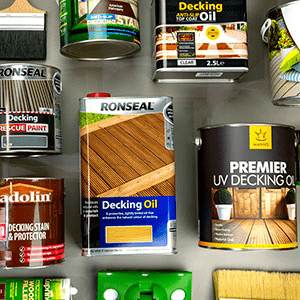Wood Dye FAQ's
What is the best way to apply wood dye?
This can vary depending on the type of dye being applied (water-based or solvent-based) but this stands as good general advice. Always read the manufacturers guidance on the product tin / container.
Mix the wood dye thoroughly before and periodically during use.
Best applied using a synthetic bristle brush, sponge, foam applicator or spray gun. A foam sponge is highly recommended when working on large flat pieces, as any heavily stained areas can be soaked up by the sponge as you work. Similarly by applying a little more pressure, more of the wood dye can be released to save time returning to the container for more.
Apply a generous coat in the direction of the wood grain leaving a little on the surface and wipe off any excess dye as you go with a clean, lint-free cloth. Allow the dye to fully dry.
Denib (lightly sand) using a fine finishing pad to loosen and remove any dry, powdery dye residue from the wood surface. Take care to remove all traces of dust with a vacuum cleaner or clean, dry microfibre cloth before sealing the dye with a suitable top coat.
What is the difference between a dye and a stain?
Essentially there is no difference between a stain and a dye, they are both coloured liquids that don't offer a sheen or protection, they simply colour the wood. Our wood dyes are very concentrated and are usually available in primary and secondary colours. Sometimes a product may have the word "stain" in its title even though it is a protective coating also. However, we believe that a wood stain should simply stain the wood and not do anything else because a better result will be achieved if clear coats are applied on top of a stain.
Can I intermix colours from the Manns Classic Wood Dye range?
Yes. All of the colours in the Manns Classic Wood Dye range can be intermixed to create new shades and diluted with water up to 50/50 to lighten the shade.
Wood Dye related blog posts
- The Essential Guide to Wood Colour
- Valentines Gifts With a Personal Touch - Part 1
- Hand Made Valentines Gifts - Part 2
Disclaimer: Whilst every attempt has been made to provide product information that is as accurate as possible, it's important to clarify that trees and the wood that they produce can be affected by many factors. For example, the same species of tree grown in the same wood, even in close proximity, will be affected by age along with the amount of sunlight and water they receive. Other naturally occurring biological and environmental factors will also influence the density and grain of the wood as well as the moisture and oil content of the timber. No two trees are the same, meaning each piece of wood has the potential to look and react differently to the same wood finish. For example, product adhesion, colour variations, absorption rates and sheen levels. It is for this reason that we always strongly recommend carrying out test areas before starting any project


